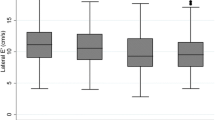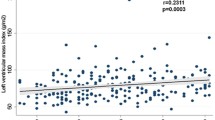Abstract
Patients with metabolic syndrome (MetS) have high cardiovascular event rates. The additional effect of MetS on left ventricular (LV) systolic function in patients with type 2 diabetes mellitus (T2DM) is unknown. We studied the relation between MetS and LV systolic function in T2DM patients without coronary artery disease (CAD). Clinical and echocardiographic data from 331 T2DM patients were analyzed. Prevalence of MetS was assessed based on NCEP ATPIII definition. Stress-corrected midwall shortening (sc-MS) and mitral annular peak systolic velocity (S’) were analyzed as indexes of circumferential and longitudinal shortening, respectively. Sc-MS was impaired if <89 %, S’ if <8.5 cm/s (10th percentile of healthy controls). MetS was diagnosed in 172 patients. Sc-MS and S’ were similar in T2DM patients with and without MetS (91 ± 14 vs 92 ± 15 %; 9.8 ± 2.0 vs 9.5 ± 2.1 cm/s, respectively; p = ns) but significantly reduced comparing to controls (102 ± 11 % and 10.8 cm/s; p < 0.0001). Impairment of sc-MS and S’ were detected in 37 vs 40 % and in 29 vs 32 % of T2DM patients with and without MetS (p = ns), respectively. LV systolic function measured as sc-MS and S’ is frequently impaired in T2DM patients without CAD; however, the coexistence of MetS is not associated with more severe LV systolic dysfunction. Further pathological mechanisms have to be considered to explain the negative prognostic impact of MetS in T2DM patients.


Similar content being viewed by others
References
Alberti KGMM, Eckel RH, Grundy SM, Zimmet PZ, Cleeman PJ, Donato KA et al (2009) Harmonizing the metabolic syndrome: a Joint Interim Statement of the International Diabetes Federation Task Force on Epidemiology and Prevention: National Heart, Lung and Blood institute; American Heart Association; World Heart Federation, International Atherosclerosis Society and International Association for the Study of Obesity. Circulation 120:1640–1645
Grundy SM, Brewer B, Cleeman JI, Smith SC Jr, Lenfant C et al (2004) Definition of metabolic syndrome. Report of the National Heart, Lung, and Blood Institute/American Heart Association Conference on Scientific Issues Related to Definition. Circulation 109:433–438
Third Report of the National Cholesterol Education Program (NCEP) (2002) Expert panel on detection, evaluation, and treatment of high blood cholesterol in adults (Adult Treatment Panel III) final report. Circulation 106:3143–3421
Balkau B, Charles MA, Drivsholm T, Borch-Johnsen K, Wareham N, Yudkin JS et al (2002) Frequency of the WHO metabolic syndrome in European cohorts, and an alternative definition of an insulin resistance syndrome. Diabetes Metab 28:364–376
Alexander CM, Landsman PB, Teutsch SM, Haffner SM (2003) NCEP-Defined metabolic syndrome, diabetes, and prevalence of coronary heart disease among NHANES III participants age 50 years and older. Diabetes 52:1210–1214
Lakka HM, Laaksonen DE, Lakka TA, Niskanen LK, Kumpusalo E, Tuomilehto J et al (2002) The metabolic syndrome and total and cardiovascular disease mortality in middle-aged men. JAMA 288:2709–2716
Ford ES, Giles WH, Mokdad AH (2004) Increasing prevalence of the metabolic syndrome among U.S. adults. Diabetes Care 27(10):2444–2449
de Simone G, Devereux RB, Chinali M, Best LG, Lee ET, Galloway JM, Resnick HE et al (2007) Impact of metabolic syndrome by different definitions in a population with high prevalence of obesity and diabetes: the strong heart study. Diabetes Care 30(7):1851–1856
Howard BV, Best LG, Galloway JM, Howad WJ, Jones K, Lee ET et al (2006) Coronary heart disease risk equivalence in diabetes depends on concomitant risk factors. Diabetes Care 29(2):391–397
Malik S, Wong ND, Franklin SS, Kamath TV, L’Italien GJ, Pio JR et al (2004) Impact of the metabolic syndrome on mortality from coronary heart disease, cardiovascular disease, and all causes in United States adults. Circulation 110:1245–1250
Schillaci G, Pirro M, Vaudo G, Gemelli F, Marchesi S, Porcellati C et al (2004) Prognostic value of the metabolic syndrome in essential hypertension. J Am Coll Cardiol 43:1817–1822
Grassi G, Quarti-Trevano F, Seravalle G, Dell’Oro R (2007) Cardiovascular risk and adrenergic overdrive in the metabolic syndrome. Nutr Metab Cardiovasc Dis 17:473–481
Mule G, Cottone S, Mongiovi R, Cusimano P, Mezzatesta G, Seddio G et al (2006) Influence of the metabolic syndrome on aortic stiffness in never treated hypertensive patients. Nutr Metab Cardiovasc Dis 16:54–59
Tartan Z, Ozer N, Uyarel H, Akgul O, Gul M, Cetin M et al (2008) Metabolic syndrome is a predictor for an ECG sign of no-reflow after primary PCI in patients with acute ST-elevation myocardial infarction. Nutr Metab Cardiovasc Dis 18(6):441–447
de Simone G, Devereux RB, Chinali M, Roman MJ, Lee ET, Resnick HE et al (2009) Metabolic syndrome and left ventricular hypertrophy in the prediction of cardiovascular events: the strong heart study. Nutr Metab Cardiovasc Dis 19(2):98–104
Cioffi G, Giorda CB, Chinali M, Di Lenarda A, Faggiano P, Lucci D et al (2012) Analysis of midwall shortening reveals high prevalence of left ventricular myocardial dysfunction in patients with diabetes mellitus: the DYDA study. Eur J Prev Cardiol 19(5):935–943
de Simone G, Devereux RB, Roman MJ, Chinali M, Barac A, Panza JA et al (2013) Does cardiovascular phenotype explain the association between diabetes and incident heart failure? The strong heart study. Nutr Metab Cardiovasc Dis 23(4):285–291
Cioffi G, Faganello G, De Feo S, Berlinghieri N, Tarantini L, Di Lenarda A et al (2013) Combined circumferential and longitudinal left ventricular systolic dysfunction in patients with type 2 diabetes mellitus without myocardial ischemia: data from the SHORTWAVE study. Exp Clin Cardiol 18:26–31
Hiestand DM, Britz P, Goldman M, Phillips B et al (2006) Prevalence of symptoms and risk of sleep apnea in the US population: results from the national sleep foundation sleep in America 2005 poll. Chest 130:780–786
Peppard PE, Young T, Palta M, Skatrud J (2000) Prospective study of the association between sleep-disordered breathing and hypertension. N Engl J Med 19:1378–1384
Levey AS, Bosch JP, Lewis JB, Greene T, Rogers N, Roth D et al (1999) A more accurate method to estimate glomerular filtration rate from serum creatinine: a new prediction equation. Ann Intern Med 130(6):461–470
Devereux RB, Alonso DR, Lutas EM, Gottlieb GJ, Campo E, Sachs I et al (1986) Echocardiographic assessment of left ventricular hypertrophy: comparison to necropsy findings. Am J Cardiol 57:450–458
de Simone G, Devereux RB, Daniels SR, Koren MJ, Meyer RA, Laragh JH et al (1995) Effect of growth on variability of left ventricular mass: assessment of allometric signals in adults and children and their capacity to predict cardiovascular risk. J Am Coll Cardiol 25:1056–1062
de Simone G, Daniels SR, Kimball TR, Roman MJ, Chinali M, Galderisi M et al (2005) Evaluation of concentric left ventricular geometry in humans: evidence for age-related systematic underestimation. Hypertension 45:64–68
de Simone G, Devereux RB, Roman MJ, Ganau A, Saba PS, Alderman MH et al (1994) Assessment of left ventricular function by the midwall fractional shortening/end-systolic stress relation in human hypertension. J Am Coll Cardiol 23:1444–1451
Sohn DW, Chai HI, Lee DJ, Kim HC, Oh BH, Lee MM et al (1997) Assessment of mitral annulus velocity by tissue Doppler imaging in the evaluation of left ventricular diastolic function. J Am Coll Cardiol 30:474–480
Nagueh SF, Appleton CP, Gillebert TC et al (2009) Recommendations for the evaluation of left ventricular diastolic function by echocardiography. J Am Soc Echocardiogr 10:165–193
Redfield MM, Jacobsen SJ, Burnett JC Jr, Mahoney DW, Bailey KR, Rodeheffer RJ (2003) Burden of systolic and diastolic ventricular dysfunction in the community: appreciating the scope of the heart failure epidemic. JAMA 289:194–202
Tadic M, Ivanovic B, Kostic N, Simic D, Matic D, Celic V (2012) Metabolic syndrome and left ventricular function: is the number of criteria actually important? Med Sci Monit 18:282–289
Yamaguchi T, Kitamori K, Ichihara G, Suzuki Y, Ochiai M, Yamada Y et al (2013) Serial changes in adipocytokines and cardiac function in a rat model of the metabolic syndrome. Clin Exp Pharmacol Physiol 40:443–448
Galderisi M, de Simone G, Innelli P, Turco A, Turco S, Capalbo B et al (2007) Impaired inotropic response in type 2 diabetes mellitus: a strain rate imaging study. Am J Hypertens 20:548–555
Ha JW, Lee HC, Kang ES, Ahn CM, Kim JM, Ahn JM et al (2007) Abnormal left ventricular longitudinal functional reserve in patients with diabetes mellitus: implication for detecting subclinical myocardial dysfunction using exercise tissue Doppler echocardiography. Heart 93:1571–1576
Devereux RB, Roman MJ, Paranicas M, O’Grady MJ, Lee ET, Welty TK et al (2000) Impacts of diabetes on cardiac function. The strong heart study. Circulation 101:2271–2276
Faden G, Faganello G, De Feo S, Berlinghieri N, Tarantini L, Di Lenarda A et al (2013) The increasing detection of asymptomatic left ventricular dysfunction in patients with type 2 diabetes mellitus without overt cardiac disease: data from the SHORTWAVE study. Diabetes Res Clin Pract 101(3):309–316
Tadic M, Ivanovic B, Celic V, Neskovic A (2013) Do nondipping pattern and metabolic syndrome impact left ventricular geometry and global function in hypertensive patients? Clin Exp Hypertens 35(8):637–644
Iozzo P, Lautamaki R, Borra R, Lehto HR, Bucci M, Viljanen A et al (2009) Contribution of glucose tolerance and sex to cardiac adiposity. J Clin Endocrinol Metab 94:4472–4482
Rijzewijk LJ, van der Meer RW, Smit JW, Diamant M, Bax JJ et al (2008) Myocardial steatosis is an independent predictor of diastolic dysfunction in type 2 diabetes mellitus. J Am Coll Cardiol 52:1793–1799
Willemsen S, Hartog JW, Hummel YM, van Ruijven MH, van der Host IC et al (2011) Tissue advanced glycation end products are associated with diastolic function and aerobic exercise capacity in diabetic heart failure patients. Eur J Heart Fail 13:76–82
Koyama Y, Takeishi Y, Arimoto T, Niizeki T, Shishido T et al (2007) High serum level of pentosidine, an advanced glycation end product (AGE), is a risk factor of patients with heart failure. J Card Fail 13:199–206
Fournier SB, Reger BL, Donley DA, Bonner DE, Warden BE, Gharib W et al (2014) Exercise reveals impairments in left ventricular systolic function in patients with metabolic syndrome. Exp Physiol 99(1):149–163
Crendal E, Walther G, Vinet A, Dutheil F, Naughton G, Lesourd B, Chapier R, Rupp T, Courteix D, Obert P (2013) Myocardial deformation and twist mechanics in adults with metabolic syndrome: impact of cumulative metabolic burden. Obesity 21(12):E679–E686
Partinen M, Jamieson A, Guilleminault C (1988) Long-term outcome for obstructive sleep apnea syndrome patients. Mortality. Chest 94:1200–1204
Cioffi G, Russo TE, Selmi A, Stefenelli C, Furlanello F (2011) Analysis of left ventricular systolic function by midwall mechanics in patients with obstructive sleep apnoea. Eur J Echocardiogr 12:61–68
Shamsuzzaman AS, Gersh BJ, Somers VK (2003) Obstructive sleep apnea: implications for cardiac and vascular disease. JAMA 290(14):1906–1914
Ha TH, Seo HS, Choo WJ, Choi J, Suh J, Cho YH et al (2011) The Effect of Metabolic Syndrome on Myocardial Contractile Reserve during Exercise in Non-Diabetic Hypertensive Subjects. J Cardiovasc Ultrasound 19:176–182
Conflict of interest
Giorgio Faganello, Giovanni Cioffi, Pompilio Faggiano, Riccardo Candido, Luigi Tarantini, Stefania De Feo, Andrea Di Lenarda, Giovanni de Simone declare that they have no conflict of interest.
Human and animal rights
All procedures followed were in accordance with the ethical standards of the responsible committee on human experimentation (institutional and national) and with the Helsinki Declaration of 1975, as revised in 2008 (5).
Informed consent
Informed consent was obtained from all patients for being included in the study.
Author information
Authors and Affiliations
Corresponding author
Additional information
Managed by Massimo Porta.
Rights and permissions
About this article
Cite this article
Faganello, G., Cioffi, G., Faggiano, P. et al. Does metabolic syndrome worsen systolic dysfunction in diabetes? The shortwave study. Acta Diabetol 52, 143–151 (2015). https://doi.org/10.1007/s00592-014-0620-0
Received:
Accepted:
Published:
Issue Date:
DOI: https://doi.org/10.1007/s00592-014-0620-0




